浅谈英汉问候语的差异与跨文化交际
- 格式:doc
- 大小:24.00 KB
- 文档页数:2
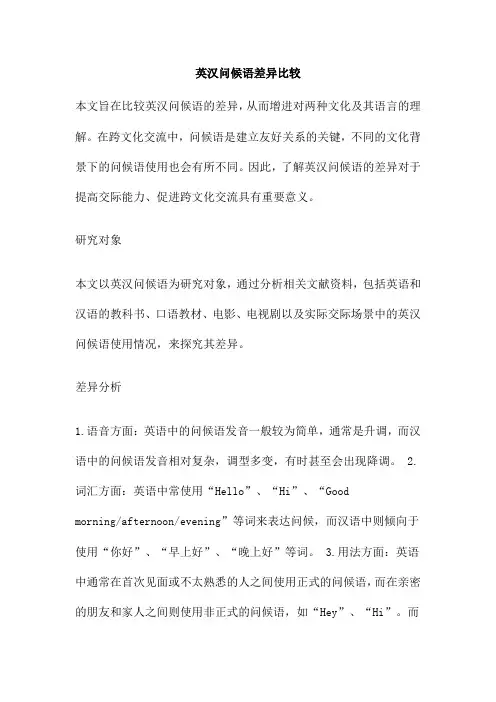
英汉问候语差异比较本文旨在比较英汉问候语的差异,从而增进对两种文化及其语言的理解。
在跨文化交流中,问候语是建立友好关系的关键,不同的文化背景下的问候语使用也会有所不同。
因此,了解英汉问候语的差异对于提高交际能力、促进跨文化交流具有重要意义。
研究对象本文以英汉问候语为研究对象,通过分析相关文献资料,包括英语和汉语的教科书、口语教材、电影、电视剧以及实际交际场景中的英汉问候语使用情况,来探究其差异。
差异分析1.语音方面:英语中的问候语发音一般较为简单,通常是升调,而汉语中的问候语发音相对复杂,调型多变,有时甚至会出现降调。
2.词汇方面:英语中常使用“Hello”、“Hi”、“Goodmorning/afternoon/evening”等词来表达问候,而汉语中则倾向于使用“你好”、“早上好”、“晚上好”等词。
3.用法方面:英语中通常在首次见面或不太熟悉的人之间使用正式的问候语,而在亲密的朋友和家人之间则使用非正式的问候语,如“Hey”、“Hi”。
而在汉语中,无论面对熟悉的人还是陌生的人,一般的问候语都是“你好”,只有在特殊场合如正式场合或书面语中才会使用较为正式的问候语。
原因探讨英汉问候语差异的原因主要可以从历史、文化、语言地位等方面进行考虑。
在历史方面,英语和汉语的发展历程截然不同,这种差异也反映在了问候语上。
此外,英汉两种文化的价值观也有所不同。
英语文化中强调个人主义,因此英语中的问候语使用较为简洁直接;而汉语文化中强调集体主义,所以汉语中的问候语使用较为温和礼貌。
此外,英汉两种语言的语言地位也有所不同。
英语是全球通用语言,而汉语则主要在中国及海外华人社区中使用。
这也导致了英汉问候语的差异。
启示与建议通过比较英汉问候语的差异,我们可以得到以下启示和建议:首先,在跨文化交流中,我们需要了解并尊重对方的文化和语言习惯。
在交际过程中,适当的调整自己的语言和表达方式,可以更好地融入对方的文化环境。
其次,教育机构在开展外语教学时,应注重培养学生的跨文化意识,让他们了解目标语言的文化背景和习惯用法。
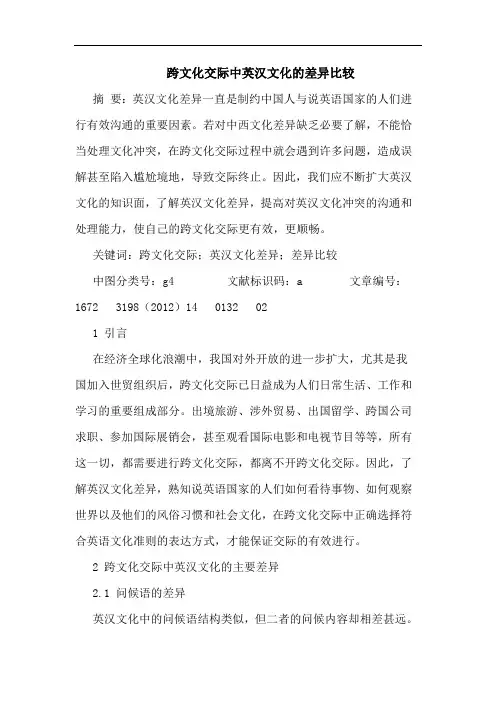
跨文化交际中英汉文化的差异比较摘要:英汉文化差异一直是制约中国人与说英语国家的人们进行有效沟通的重要因素。
若对中西文化差异缺乏必要了解,不能恰当处理文化冲突,在跨文化交际过程中就会遇到许多问题,造成误解甚至陷入尴尬境地,导致交际终止。
因此,我们应不断扩大英汉文化的知识面,了解英汉文化差异,提高对英汉文化冲突的沟通和处理能力,使自己的跨文化交际更有效,更顺畅。
关键词:跨文化交际;英汉文化差异;差异比较中图分类号:g4 文献标识码:a 文章编号:16723198(2012)140132021 引言在经济全球化浪潮中,我国对外开放的进一步扩大,尤其是我国加入世贸组织后,跨文化交际已日益成为人们日常生活、工作和学习的重要组成部分。
出境旅游、涉外贸易、出国留学、跨国公司求职、参加国际展销会,甚至观看国际电影和电视节目等等,所有这一切,都需要进行跨文化交际,都离不开跨文化交际。
因此,了解英汉文化差异,熟知说英语国家的人们如何看待事物、如何观察世界以及他们的风俗习惯和社会文化,在跨文化交际中正确选择符合英语文化准则的表达方式,才能保证交际的有效进行。
2 跨文化交际中英汉文化的主要差异2.1 问候语的差异英汉文化中的问候语结构类似,但二者的问候内容却相差甚远。
英语问候语直接明了,不涉及个人隐私的话题,是中性的。
英语常用的问候语有:hi/hello!(你好!)good morning!(早上好!)good evening!(晚上好!)how are you?(你好吗?)nice to meet you!(很高兴见到你!)说英语国家的人通常以谈论天气、兴趣爱好、旅游度假、电视电影等为话题,进一步进行交流来促进人际关系,在交谈中忌讳谈论宗教信仰、婚姻状况、经济收入和年龄等涉及隐私方面的话题。
而汉语问候语强调客套超于事实,中国人打招呼习惯于用“吃饭没?”“去哪呀?”“多大啦?”甚至“每月能挣多少钱?”等,体现对别人的关心。
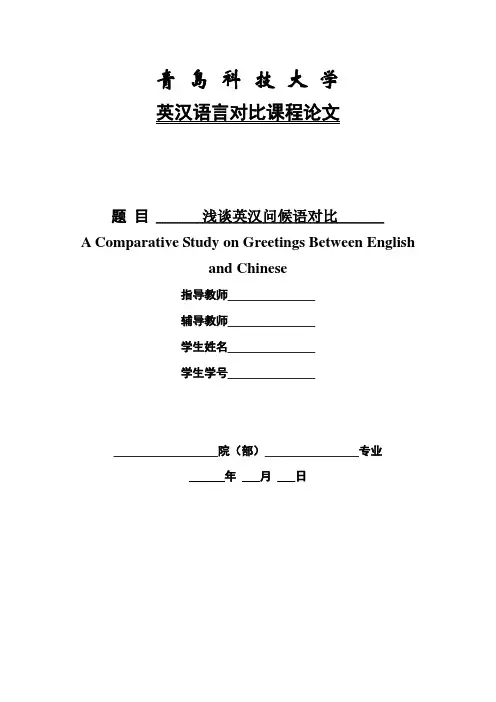
青岛科技大学英汉语言对比课程论文浅谈英汉问候语对比题目 __________________________________A Comparative Study on Greetings Between Englishand Chinese指导教师__________________________辅导教师__________________________学生姓名__________________________学生学号__________________________院(部)____________________________专业_____________________________________年 ___月 ___日摘要问候语是人与人之间为了维持关系而说出的一种具有寒暄功能的语言,它一般不承载信息,就是为了打招呼,也就是说,它只具有感情功能而不具有信息功能。
问候语是人际交往的第一步,是交谈得以实现的基础。
不管哪种语言团体,问候语都是人与人交流不可缺少的一部分。
但是不同的语言团体由于文化习俗的不同,问候语的表达习惯及使用方法也不同。
如果不了解这其中的差异,就会在跨文化交际中引起不必要的误会。
因此,本文旨在研究英语和汉语问候语之间的异同,通过比较,了解英汉问候语在内容,意义,结构和称谓方面的差别,从而使我们更加了解问候语,在以后的使用中更加灵活自如。
关键词:问候语交际差异内容结构称谓AbstractGreeting is a kind of phatic language which is used to sustain relationship between people. It is emotive rather than informative since it is just for greeting each other. Greeting is the first step for communication and is what the communication is based on. No matter which language community is, greeting is an indispensible part of language. However, the means of presentation and usage of various languages differ sharply due to different cultures and customs. If we do not know the distinctions between them, we will inevitably cause misunderstandings between each other. Hence, this paper centers on the difference and similarities between Chinese and English greetings. Through contrast, we will be familiar with the difference between Chinese and English greetings through content, meaning, structure and appellation, which is of great help for us to use them freely and flexibly.Key words: greeting communication difference content structure title目录一.问候语的定义 (1)二.问候语的功能 (1)三.英汉问候语的相同点 (2)1.关于双向 (2)2.关于主题 (2)四.英汉问候语的不同点 (3)1.内容差别 (3)2.意义差别 (3)3.结构差别 (4)4.称谓差别 (4)五.结论 (5)六.参考文献 (6)一.问候语的定义在人们见面的时候,为了社会关系的需要,会说出一种话语来拉近彼此的关系,这就是问候语,它又叫见面语、招呼语,它短小简单,是人们生活中最常用的重要交际口语。
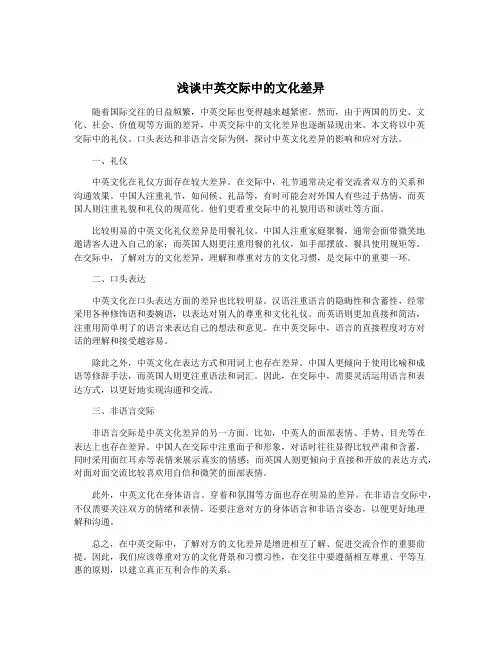
浅谈中英交际中的文化差异随着国际交往的日益频繁,中英交际也变得越来越紧密。
然而,由于两国的历史、文化、社会、价值观等方面的差异,中英交际中的文化差异也逐渐显现出来。
本文将以中英交际中的礼仪、口头表达和非语言交际为例,探讨中英文化差异的影响和应对方法。
一、礼仪中英文化在礼仪方面存在较大差异。
在交际中,礼节通常决定着交流者双方的关系和沟通效果。
中国人注重礼节,如问候、礼品等,有时可能会对外国人有些过于热情,而英国人则注重礼貌和礼仪的规范化。
他们更看重交际中的礼貌用语和谈吐等方面。
比较明显的中英文化礼仪差异是用餐礼仪。
中国人注重家庭聚餐,通常会面带微笑地邀请客人进入自己的家;而英国人则更注重用餐的礼仪,如手部摆放、餐具使用规矩等。
在交际中,了解对方的文化差异,理解和尊重对方的文化习惯,是交际中的重要一环。
二、口头表达中英文化在口头表达方面的差异也比较明显。
汉语注重语言的隐晦性和含蓄性,经常采用各种修饰语和委婉语,以表达对别人的尊重和文化礼仪。
而英语则更加直接和简洁,注重用简单明了的语言来表达自己的想法和意见。
在中英交际中,语言的直接程度对方对话的理解和接受越容易。
除此之外,中英文化在表达方式和用词上也存在差异。
中国人更倾向于使用比喻和成语等修辞手法,而英国人则更注重语法和词汇。
因此,在交际中,需要灵活运用语言和表达方式,以更好地实现沟通和交流。
三、非语言交际非语言交际是中英文化差异的另一方面。
比如,中英人的面部表情、手势、目光等在表达上也存在差异。
中国人在交际中注重面子和形象,对话时往往显得比较严肃和含蓄,同时采用面红耳赤等表情来展示真实的情感;而英国人则更倾向于直接和开放的表达方式,对面对面交流比较喜欢用自信和微笑的面部表情。
此外,中英文化在身体语言、穿着和氛围等方面也存在明显的差异。
在非语言交际中,不仅需要关注双方的情绪和表情,还要注意对方的身体语言和非语言姿态,以便更好地理解和沟通。
总之,在中英交际中,了解对方的文化差异是增进相互了解、促进交流合作的重要前提。
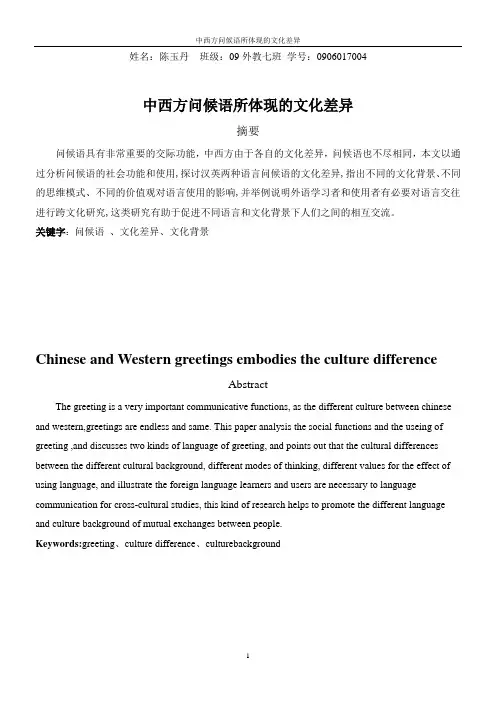
姓名:陈玉丹班级:09外教七班学号:0906017004中西方问候语所体现的文化差异摘要问候语具有非常重要的交际功能,中西方由于各自的文化差异,问候语也不尽相同,本文以通过分析问候语的社会功能和使用,探讨汉英两种语言问候语的文化差异,指出不同的文化背景、不同的思维模式、不同的价值观对语言使用的影响,并举例说明外语学习者和使用者有必要对语言交往进行跨文化研究,这类研究有助于促进不同语言和文化背景下人们之间的相互交流。
关键字:问候语、文化差异、文化背景Chinese and Western greetings embodies the culture differenceAbstractThe greeting is a very important communicative functions, as the different culture between chinese and western,greetings are endless and same. This paper analysis the social functions and the useing of greeting ,and discusses two kinds of language of greeting, and points out that the cultural differences between the different cultural background, different modes of thinking, different values for the effect of using language, and illustrate the foreign language learners and users are necessary to language communication for cross-cultural studies, this kind of research helps to promote the different language and culture background of mutual exchanges between people.Keywords:greeting、culture difference、culturebackground引言问候是日常交际中最基本的一种礼仪。
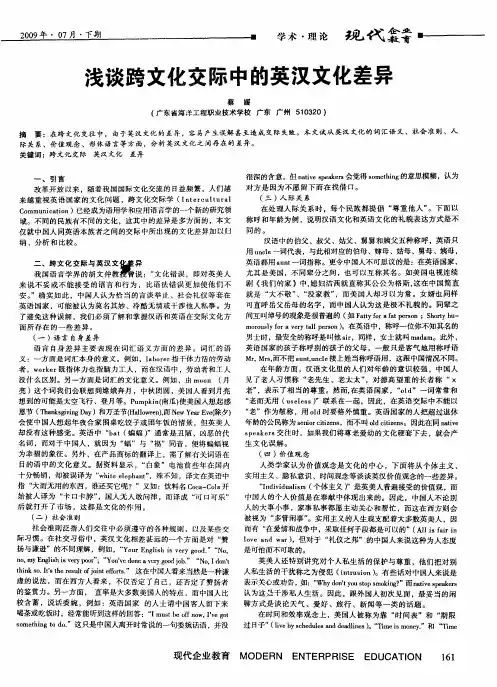
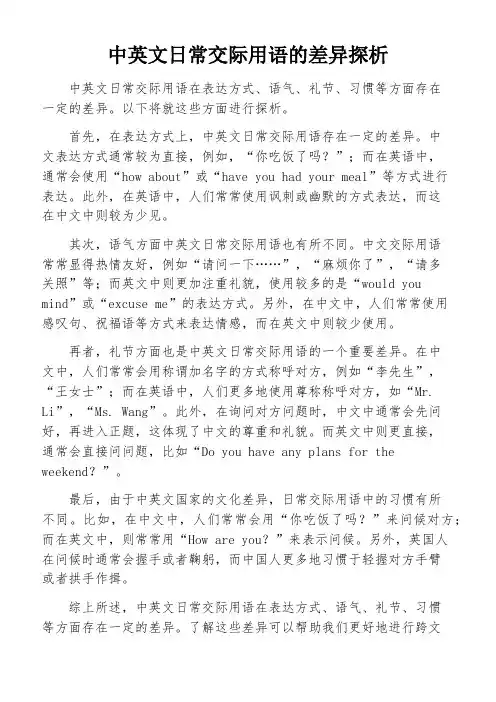
中英文日常交际用语的差异探析中英文日常交际用语在表达方式、语气、礼节、习惯等方面存在一定的差异。
以下将就这些方面进行探析。
首先,在表达方式上,中英文日常交际用语存在一定的差异。
中文表达方式通常较为直接,例如,“你吃饭了吗?”;而在英语中,通常会使用“how about”或“have you had your meal”等方式进行表达。
此外,在英语中,人们常常使用讽刺或幽默的方式表达,而这在中文中则较为少见。
其次,语气方面中英文日常交际用语也有所不同。
中文交际用语常常显得热情友好,例如“请问一下……”,“麻烦你了”,“请多关照”等;而英文中则更加注重礼貌,使用较多的是“would you mind”或“excuse me”的表达方式。
另外,在中文中,人们常常使用感叹句、祝福语等方式来表达情感,而在英文中则较少使用。
再者,礼节方面也是中英文日常交际用语的一个重要差异。
在中文中,人们常常会用称谓加名字的方式称呼对方,例如“李先生”,“王女士”;而在英语中,人们更多地使用尊称称呼对方,如“Mr. Li”,“Ms. Wang”。
此外,在询问对方问题时,中文中通常会先问好,再进入正题,这体现了中文的尊重和礼貌。
而英文中则更直接,通常会直接问问题,比如“Do you have any plans for the weekend?”。
最后,由于中英文国家的文化差异,日常交际用语中的习惯有所不同。
比如,在中文中,人们常常会用“你吃饭了吗?”来问候对方;而在英文中,则常常用“How are you?”来表示问候。
另外,英国人在问候时通常会握手或者鞠躬,而中国人更多地习惯于轻握对方手臂或者拱手作揖。
综上所述,中英文日常交际用语在表达方式、语气、礼节、习惯等方面存在一定的差异。
了解这些差异可以帮助我们更好地进行跨文化交流,提高沟通效果。
对于学习英语的人来说,学习和理解这些差异是非常重要的。
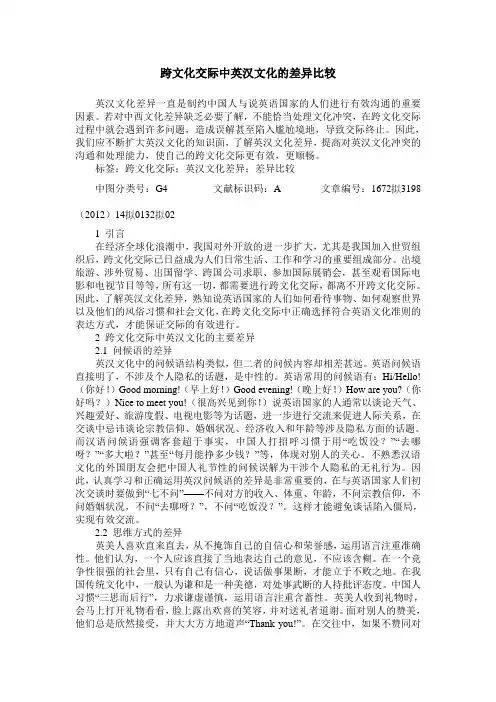
跨文化交际中英汉文化的差异比较英汉文化差异一直是制约中国人与说英语国家的人们进行有效沟通的重要因素。
若对中西文化差异缺乏必要了解,不能恰当处理文化冲突,在跨文化交际过程中就会遇到许多问题,造成误解甚至陷入尴尬境地,导致交际终止。
因此,我们应不断扩大英汉文化的知识面,了解英汉文化差异,提高对英汉文化冲突的沟通和处理能力,使自己的跨文化交际更有效,更顺畅。
标签:跨文化交际;英汉文化差异;差异比较中图分类号:G4 文献标识码:A 文章编号:16723198(2012)140132021 引言在经济全球化浪潮中,我国对外开放的进一步扩大,尤其是我国加入世贸组织后,跨文化交际已日益成为人们日常生活、工作和学习的重要组成部分。
出境旅游、涉外贸易、出国留学、跨国公司求职、参加国际展销会,甚至观看国际电影和电视节目等等,所有这一切,都需要进行跨文化交际,都离不开跨文化交际。
因此,了解英汉文化差异,熟知说英语国家的人们如何看待事物、如何观察世界以及他们的风俗习惯和社会文化,在跨文化交际中正确选择符合英语文化准则的表达方式,才能保证交际的有效进行。
2 跨文化交际中英汉文化的主要差异2.1 问候语的差异英汉文化中的问候语结构类似,但二者的问候内容却相差甚远。
英语问候语直接明了,不涉及个人隐私的话题,是中性的。
英语常用的问候语有:Hi/Hello!(你好!)Good morning!(早上好!)Good evening!(晚上好!)How are you?(你好吗?)Nice to meet you!(很高兴见到你!)说英语国家的人通常以谈论天气、兴趣爱好、旅游度假、电视电影等为话题,进一步进行交流来促进人际关系,在交谈中忌讳谈论宗教信仰、婚姻状况、经济收入和年龄等涉及隐私方面的话题。
而汉语问候语强调客套超于事实,中国人打招呼习惯于用“吃饭没?”“去哪呀?”“多大啦?”甚至“每月能挣多少钱?”等,体现对别人的关心。
不熟悉汉语文化的外国朋友会把中国人礼节性的问候误解为干涉个人隐私的无礼行为。
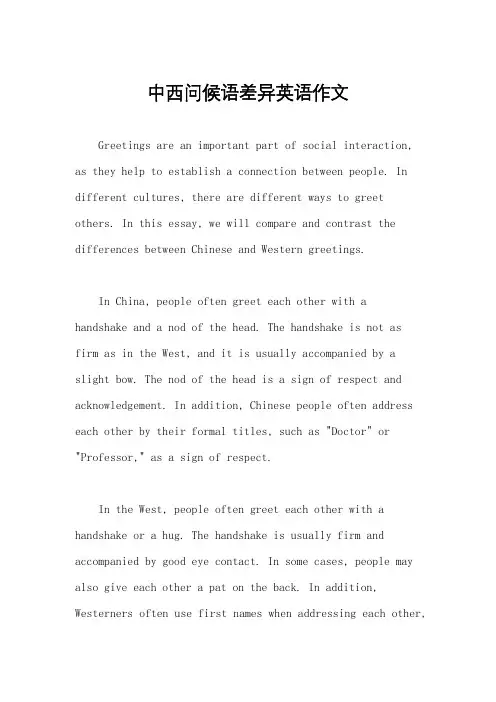
中西问候语差异英语作文Greetings are an important part of social interaction, as they help to establish a connection between people. In different cultures, there are different ways to greet others. In this essay, we will compare and contrast the differences between Chinese and Western greetings.In China, people often greet each other with a handshake and a nod of the head. The handshake is not asfirm as in the West, and it is usually accompanied by a slight bow. The nod of the head is a sign of respect and acknowledgement. In addition, Chinese people often address each other by their formal titles, such as "Doctor" or "Professor," as a sign of respect.In the West, people often greet each other with a handshake or a hug. The handshake is usually firm and accompanied by good eye contact. In some cases, people may also give each other a pat on the back. In addition, Westerners often use first names when addressing each other,even in formal settings.Another difference between Chinese and Western greetings is the use of small talk. In China, it is common to ask about a person's health, family, and work before getting down to business. This is seen as a way toestablish a personal connection and build trust. In the West, small talk is also common, but it tends to be more informal and focused on current events or shared interests.Finally, the way in which people say goodbye also differs between Chinese and Western cultures. In China, it is common to say "再见" (zài jiàn), which means "see you again," or "下次见" (xià cì jiàn), which means "until next time." In the West, people often say "goodbye" or "see you later," and may also give a wave or a hug.In conclusion, while there are some similarities between Chinese and Western greetings, such as the use of a handshake, there are also significant differences in terms of the level of formality, the use of small talk, and the way in which people say goodbye. By understanding thesedifferences, we can better navigate cross-cultural interactions and build stronger relationships with people from different backgrounds.。
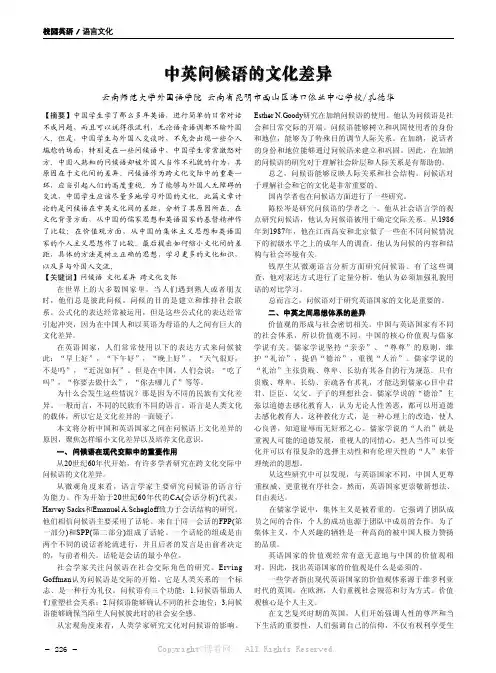
- 226-校园英语 /中英问候语的文化差异云南师范大学外国语学院 云南省昆明市西山区海口依兰中心学校/孔德华【摘要】中国学生学了那么多年英语,进行简单的日常对话不成问题,而且可以说得很流利,无论语音语调都不输外国人。
但是,中国学生与外国人交谈时,不免会出现一些令人尴尬的场面,特别是在一些问候语中,中国学生常常激怒对方。
中国人熟知的问候语却被外国人当作不礼貌的行为,其原因在于文化间的差异。
问候语作为跨文化交际中的重要一环,应当引起人们的高度重视。
为了能够与外国人无障碍的交流,中国学生应该尽量多地学习外国的文化。
此篇文章讨论的是问候语在中英文化间的差距,分析了其原因所在。
在文化背景方面,从中国的儒家思想和英语国家的基督精神作了比较;在价值观方面,从中国的集体主义思想和英语国家的个人主义思想作了比较。
最后提出如何缩小文化间的差距,具体的方法是树立正确的思想,学习更多的文化知识,以及多与外国人交流。
【关键词】问候语 文化差异 跨文化交际在世界上的大多数国家里,当人们遇到熟人或者朋友时,他们总是彼此问候。
问候的目的是建立和维持社会联系。
公式化的表达经常被运用,但是这些公式化的表达经常引起冲突,因为在中国人和以英语为母语的人之间有巨大的文化差异。
在英语国家,人们常常使用以下的表达方式来问候彼此:“早上好”,“下午好”,“晚上好”,“天气很好,不是吗”,“近况如何”。
但是在中国,人们会说:“吃了吗”,“你要去做什么”,“你去哪儿了”等等。
为什么会发生这些情况?那是因为不同的民族有文化差异。
一般而言,不同的民族有不同的语言。
语言是人类文化的载体,所以它是文化差异的一面镜子。
本文将分析中国和英语国家之间在问候语上文化差异的原因,聚焦怎样缩小文化差异以及培养文化意识。
一、 问候语在现代交际中的重要作用从20世纪60年代开始,有许多学者研究在跨文化交际中问候语的文化差异。
从微观角度来看,语言学家主要研究问候语的语言行为能力。
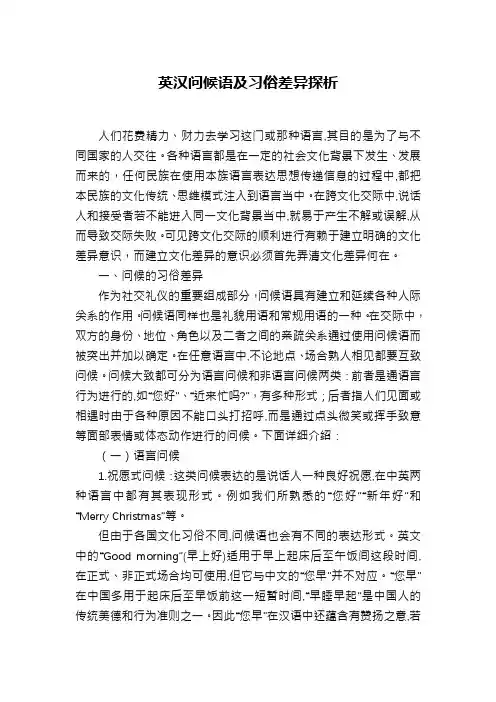
英汉问候语及习俗差异探析人们花费精力、财力去学习这门或那种语言,其目的是为了与不同国家的人交往。
各种语言都是在一定的社会文化背景下发生、发展而来的,任何民族在使用本族语言表达思想传递信息的过程中,都把本民族的文化传统、思维模式注入到语言当中。
在跨文化交际中,说话人和接受者若不能进入同一文化背景当中,就易于产生不解或误解,从而导致交际失败。
可见跨文化交际的顺利进行有赖于建立明确的文化差异意识,而建立文化差异的意识必须首先弄清文化差异何在。
一、问候的习俗差异作为社交礼仪的重要组成部分,问候语具有建立和延续各种人际关系的作用。
问候语同样也是礼貌用语和常规用语的一种。
在交际中,双方的身份、地位、角色以及二者之间的亲疏关系通过使用问候语而被突出并加以确定。
在任意语言中,不论地点、场合熟人相见都要互致问候。
问候大致都可分为语言问候和非语言问候两类:前者是通语言行为进行的,如“您好”、“近来忙吗?”,有多种形式;后者指人们见面或相遇时由于各种原因不能口头打招呼,而是通过点头微笑或挥手致意等面部表情或体态动作进行的问候。
下面详细介绍:(一)语言问候1.祝愿式问候:这类问候表达的是说话人一种良好祝愿,在中英两种语言中都有其表现形式。
例如我们所熟悉的“您好”“新年好”和“Merry Christmas”等。
但由于各国文化习俗不同,问候语也会有不同的表达形式。
英文中的“Good morning”(早上好)适用于早上起床后至午饭间这段时间,在正式、非正式场合均可使用,但它与中文的“您早”并不对应。
“您早”在中国多用于起床后至早饭前这一短暂时间,“早睡早起”是中国人的传统美德和行为准则之一。
因此“您早”在汉语中还蕴含有赞扬之意,若上午10点见人还说“您早”,则多有暗讽之意了。
2.关切式问候:关切式问候一般体现说话人对对方身体或工作、生活等方面的关心。
中国普通老百姓的日常问候语“吃了吗”、“去哪儿”、“忙不忙”等均是。
此种问候语极为普通随便,问答的双方都不把它当成正式的问题。
From English-Chinese Greetings See the Differences between Chinese and WesternCultureClass:two Number:200814025226 Name:Zhong XinghuaAs a conventional greeting terms, it is widely used in the human daily language communication. In Chinese and western cross-cultural communication, the started contact between people is greeted each other. Some with profound "China brand" greeting in western eye is puzzled; Some with a "western characteristic" greeting for Chinese people also don't understand. This mutual view about "don't understand" serious impact on the smooth communication, even caused serious cultural conflict, so I think it is necessary to find out the deep reason, and take some measures to avoid the cultural conflict.1. the conflict on languageThe greeting is the most common people's life of oral communication, it is the beginning to cut the topic, so the usage of greeting is directly related to communicatesmoothly. Erving Goffman thought the greeting is communicative signal of the beginning to recognize. China and the western countries have different cultural background, different historical origin.In greeting, the language of them also have a big difference. For example, the Chinese meeting and greeting people often used to say "you eat?" (Have you had the meal?) , "where to go?" (Where are you going?) and so on, as people life changes in the concept of, new greetings appears, such as "a raise?" (Have you got your salary raised?) , "You went out to play in holidays?" (Have you been traveling during the holidays?)and so on.As for the Chinese speaking, these are very common greeting and it's literally words, they care to each other, and the fine words about their asking can reflect the concern to others, but westerners may anger, they thought it was inquiring about other people's privacy, not polite behavior, is not appropriate topic, was disgusted. Westerners meet an acquaintance in the most commonly say “hello” that is "Good morning" ,"Good afternoon"or "Good night" (Good evening), and so on. Western greetings content is simple, is not mixed withspecific information, just on the meaning of expressing politeness. But ,for Chinese people, this is not enough enthusiasm greeting. The language content to difference of the Chinese and western is not successful communication, which is the language of the conflict. Greeting from language style aspect, there are also differences between Chinese and western. In China, for example, people mention their partners are more implicative tactful, some women to greet him when says "you damn fool", this make westerners puzzled, don't understand what's so called their husband. In the west, between a husband and wife say "hello" common "dear", this kind of word call our lover to show the feeling of happiness, but this style of greetings in China does not exist more.We all know, the language is the tool to exchange of information.As one of the language, it will lead to different language of the conflict, the language differences in essence reflect the cultural conflict. The language is a part of the culture, at the same time, it is the carrier of culture. Words can't exist separating from culture, because language can see a variety of ethnicculture. E. t. Hall said: "culture is humanized life environment. Every aspect of human life is from the influence of culture and with the cultural changes ,or rather, the existence of cultural decided, including self expression way and swept away way." Knowing the culture to the research of the language is very important. So, through the surface analysis greetings, the conflict on language is actually different from analyzing of the cultures of the conflict.2. cultural conflictAlong with the development of economic globalization, the diverse culture exist the phenomenon of popularization.we are bringing in different cultures of western society people more and more opportunities. In this case, in order to achieve successful cross-cultural communication, in order to achieve "universal harmony", the author thinks that we need to understand the differences between the Chinese and western culture and the differences of cultural conflict brought, from which we can avoid further this conflict happened, so as to promote between Chinese and western greetings and conversation better.(1) greetings clubby code viewGreetings communication standard is a man in the communication what to do and not to do what is basic principle and attitude. In Chinese and western different cultural background, people often say "hello" communication in their own place or social standards of behavior to determine each other behavior of rationality. The standards of behavior is different, it often can cause unhappy, even the conflict on communication. For example, when the Chinese say "hello" child, like on the other side, head gently patting or clench ears to show friendly. The greeting in western eye is highly respect the practice of children, parents will be very angry and resentful. Say so, in cross-cultural communication, people to identify and correct usage of behavioral standards to ensure that communication is smooth. (2) "benevolence" conceptIn Chinese traditional culture, "benevolence" the idea to communication language influence, especially in the choice of greeting. "Just the lover" require people to live together in harmony, helping others, caring and loving for others to sympathy. In this principle, peopleare actively building harmonious relations between people, trying to establish mutual affection. This kind of care about each other in human relations is based on greeting the selection of language effect. It makes people communicate with care, as far as possible to remind the greeting and greet each other, such as "the day was cold and wearing more" (It 's so cold that you need wear more clothes.), "Don't tired" (Don' t be tired.), and so on. This kind of greeting to be gradually expandto greet the aspects of the basic necessities, involving the other party of the health, life, family and various aspects of personal situation. In the Chinese view, this is a decent greeting type, it will closes the distance, build a kind of sweet atmosphere, but this kind of greeting can cause westerners antipathy, resulting in the communication misunderstandings and cut off.3. Cross cultural conflict strategic countermeasures (1) respecting personality and characteristicsIn order to avoid the conflict on language, incross-cultural communication, we need to learn from each other's cultures and pragmatic habit and thedifferences between Chinese and western culture objectively. In order to strengthen the understanding of these differences, we should read western culture background and related books through watching the film and TV programs. Westerners in exchange greetings had better convert western daily to greet, also want to spread the national culture essence, make the other side can also understand the differences. we mustrespect ,understand and compare, eventually to exchange and communicate.(2) joining the foreign languageOur aim is eliminating communicating conflicts, learning to this group communication culture, to foster intercultural communication competence. The final purpose of foreign language learning is to improve intercultural communication competence. The classroom is the main place of foreign language learning. So as a foreign language teacher, in the teaching of foreign language at the same time should use class to communicate culture content, it should include cultural phenomenon , descripte deep cultural explored. Only in this way, students can understand the western cultureand cultivate their different cultural tolerance ability. (3) in-depth study Chinese and western daily languageIn order to conform to the global integration, in order to strengthen the different language and cultureof the people mutual understanding and communication, some daily language, such as the greeting, farewell language and thank words need to study so as to promote the daily cross-cultural communication, achieve a global integral harmony.In short, the greeting is an important form of speech communication. Understanding the differences between Chinese and western greeting and leading to the differences of cultural conflict need time, people have responsibility to analyze these conflicts and find good countermeasures to resolve these conflicts, so do the real intercultural communication.。
第三节:问候语的差异问候是一种常见的礼貌行为,不管是在中国还是在西方,见到朋友或熟人都理应打声招呼。
但中西方的问候用语却有所不同。
不同的民族有着不同的文化、历史、风俗习惯和风土人情等,不注重中西问候差异,就会产生很多消极的影响,例如:词不达意,或不符合表达的习惯。
这就会导致不必要的误解,产生尴尬。
这些都是我们应学会避免的。
在中国见面时,往往是这样打招呼的:“吃了吗”(Have you eaten Have you hadyour meal).“你到哪里去”(Where are you going).“你在忙什么”( What are you doing Are youbusy).在西方,一般见面时常用以下问候用语:1.按时间来打招呼,“Good morning (早安) !”、“Good evening (晚安) !”2. 谈近况“ How do you do (你好) !”、“How are you (身体好吗) ”“What’sgoing on with you recently (最近如何) ”、“How’s everything going (一切都顺利吗) ”、“Long time no see. How are you (好久不见了, 你好吗)”、“How is your husband\wife (夫人\丈夫好吗) ”、“Is everything all right with the children (孩子们都好吗) ”、“Have you been on holiday (最近休假去了吗) ”3.谈天气,如“It’s sunny。
”或“what a bad day,isn't it”“How do you like the weather here (你喜欢这里的气候吗) ”注意:对新结识的人一般以谈论天气为问候语。
或者以其他与个人没有直接关系的事物为问候语例如: “Is this your first time to behere (你这是第一次来我国吗) ”、“How long have you been here (到我国来多久了) ”、“Is this your first position abroad (这是你在国外第一次任职吗) ”。
From English-Chinese Greetings See the Differences between Chinese and WesternCultureClass:two Number:200814025226 Name:Zhong XinghuaAs a conventional greeting terms, it is widely used in the human daily language communication. In Chinese and western cross-cultural communication, the started contact between people is greeted each other. Some with profound "China brand" greeting in western eye is puzzled; Some with a "western characteristic" greeting for Chinese people also don't understand. This mutual view about "don't understand" serious impact on the smooth communication, even caused serious cultural conflict, so I think it is necessary to find out the deep reason, and take some measures to avoid the cultural conflict.1. the conflict on languageThe greeting is the most common people's life of oral communication, it is the beginning to cut the topic, so the usage of greeting is directly related to communicatesmoothly. Erving Goffman thought the greeting is communicative signal of the beginning to recognize. China and the western countries have different cultural background, different historical origin.In greeting, the language of them also have a big difference. For example, the Chinese meeting and greeting people often used to say "you eat?" (Have you had the meal?) , "where to go?" (Where are you going?) and so on, as people life changes in the concept of, new greetings appears, such as "a raise?" (Have you got your salary raised?) , "You went out to play in holidays?" (Have you been traveling during the holidays?)and so on.As for the Chinese speaking, these are very common greeting and it's literally words, they care to each other, and the fine words about their asking can reflect the concern to others, but westerners may anger, they thought it was inquiring about other people's privacy, not polite behavior, is not appropriate topic, was disgusted. Westerners meet an acquaintance in the most commonly say “hello” that is "Good morning" ,"Good afternoon"or "Good night" (Good evening), and so on. Western greetings content is simple, is not mixed withspecific information, just on the meaning of expressing politeness. But ,for Chinese people, this is not enough enthusiasm greeting. The language content to difference of the Chinese and western is not successful communication, which is the language of the conflict. Greeting from language style aspect, there are also differences between Chinese and western. In China, for example, people mention their partners are more implicative tactful, some women to greet him when says "you damn fool", this make westerners puzzled, don't understand what's so called their husband. In the west, between a husband and wife say "hello" common "dear", this kind of word call our lover to show the feeling of happiness, but this style of greetings in China does not exist more.We all know, the language is the tool to exchange of information.As one of the language, it will lead to different language of the conflict, the language differences in essence reflect the cultural conflict. The language is a part of the culture, at the same time, it is the carrier of culture. Words can't exist separating from culture, because language can see a variety of ethnicculture. E. t. Hall said: "culture is humanized life environment. Every aspect of human life is from the influence of culture and with the cultural changes ,or rather, the existence of cultural decided, including self expression way and swept away way." Knowing the culture to the research of the language is very important. So, through the surface analysis greetings, the conflict on language is actually different from analyzing of the cultures of the conflict.2. cultural conflictAlong with the development of economic globalization, the diverse culture exist the phenomenon of popularization.we are bringing in different cultures of western society people more and more opportunities. In this case, in order to achieve successful cross-cultural communication, in order to achieve "universal harmony", the author thinks that we need to understand the differences between the Chinese and western culture and the differences of cultural conflict brought, from which we can avoid further this conflict happened, so as to promote between Chinese and western greetings and conversation better.(1) greetings clubby code viewGreetings communication standard is a man in the communication what to do and not to do what is basic principle and attitude. In Chinese and western different cultural background, people often say "hello" communication in their own place or social standards of behavior to determine each other behavior of rationality. The standards of behavior is different, it often can cause unhappy, even the conflict on communication. For example, when the Chinese say "hello" child, like on the other side, head gently patting or clench ears to show friendly. The greeting in western eye is highly respect the practice of children, parents will be very angry and resentful. Say so, in cross-cultural communication, people to identify and correct usage of behavioral standards to ensure that communication is smooth. (2) "benevolence" conceptIn Chinese traditional culture, "benevolence" the idea to communication language influence, especially in the choice of greeting. "Just the lover" require people to live together in harmony, helping others, caring and loving for others to sympathy. In this principle, peopleare actively building harmonious relations between people, trying to establish mutual affection. This kind of care about each other in human relations is based on greeting the selection of language effect. It makes people communicate with care, as far as possible to remind the greeting and greet each other, such as "the day was cold and wearing more" (It 's so cold that you need wear more clothes.), "Don't tired" (Don' t be tired.), and so on. This kind of greeting to be gradually expand to greet the aspects of the basic necessities, involving the other party of the health, life, family and various aspects of personal situation. In the Chinese view, this is a decent greeting type, it will closes the distance, build a kind of sweet atmosphere, but this kind of greeting can cause westerners antipathy, resulting in the communication misunderstandings and cut off.3. Cross cultural conflict strategic countermeasures (1) respecting personality and characteristicsIn order to avoid the conflict on language, in cross-cultural communication, we need to learn from each other's cultures and pragmatic habit and the differencesbetween Chinese and western culture objectively. In order to strengthen the understanding of these differences, we should read western culture background and related books through watching the film and TV programs. Westerners in exchange greetings had better convert western daily to greet, also want to spread the national culture essence, make the other side can also understand the differences. we must respect,understand and compare, eventually to exchange and communicate.(2) joining the foreign languageOur aim is eliminating communicating conflicts, learning to this group communication culture, to foster intercultural communication competence. The final purpose of foreign language learning is to improve intercultural communication competence. The classroom is the main place of foreign language learning. So as a foreign language teacher, in the teaching of foreign language at the same time should use class to communicate culture content, it should include cultural phenomenon , descripte deep cultural explored. Only in this way, students can understand the western cultureand cultivate their different cultural tolerance ability. (3) in-depth study Chinese and western daily languageIn order to conform to the global integration, in order to strengthen the different language and culture of the people mutual understanding and communication, some daily language, such as the greeting, farewell language and thank words need to study so as to promote the daily cross-cultural communication, achieve a global integral harmony.In short, the greeting is an important form of speech communication. Understanding the differences between Chinese and western greeting and leading to the differences of cultural conflict need time, people have responsibility to analyze these conflicts and find good countermeasures to resolve these conflicts, so do the real intercultural communication.。
ENGLISH ON CAMPUS2023年02期总第650期跨文化交际视域下英汉语言文化差异及应对探析随着全球化的发展,各国之间的交流日益密切。
而不同国家之间由于历史文化的不同,也形成了不同的语言文化。
而语言作为沟通的媒介,在文化差异的影响下,容易使人们的交流产生误解。
而跨文化交际既与现代社会发展趋势相符合,能有效推动我国经济建设和社会发展,还能进一步强化文化自信,在跨文化交际中推动我国传统文化的弘扬与发展,提升我国的国际地位。
对此,跨文化交际视域下,探究英汉语言文化差异能更好地应对跨文化交际障碍,实现英汉语言互通自由,是当前学术界须重点研究的问题。
一、跨文化交际概述跨文化交际(Intercultural Communication或Cross-Cultural Communication)即不同文化背景的人群展开交际的行为。
其交际内容包括本族语言和外来语言两部分内容,并通过交际行为达到交流目的。
这种交流的主体双方可以是任何两个在语言表达方式以及文化背景方面存在差异的人群。
基于不同的语言文化背景,在进行跨文化交际时,多需要运用到语言翻译。
在翻译过程中,更需要重视不同文化背景下的语言表达禁忌。
二、跨文化交际视域下英汉语言文化差异对比基于不同的生活环境、文化背景、历史发展等,不同语言之间的跨文化交际中存在一些地域性的文化差异。
具体分析如下:(一)问候语文化差异问候语形式方面。
不同文化交际中有不同的语言习惯。
例如在英语中,通常将“Good morning”“Good afternoon”“Hello”等问候语用于各类场合,但汉语问候语中,在非正式场合,更倾向于使用“早”“吃过了吗”“回来了”等问候语。
此外,为了表示礼貌,虽然英语和汉语都会使用到称谓词,但汉语更强调交际双方的身份地位,例如“张阿姨好”“李奶奶,最近身体不错”等。
但英语文化中更重视人与人之间身份的平等,在一些非正式场合之中,可能会直呼对方姓名,以表示亲近。
创造能力与才能,才会适应当今社会对人才发展的要求。
二、高校素质教育中开展艺术教育的途径高校实施艺术教育的关键环节,是将艺术课程所包括的音乐艺术、美术欣赏、文学欣赏、影视欣赏、舞蹈艺术、建筑艺术等有机地渗透到素质教育教学的体系当中,而提高艺术教师的整体素质就成为搞好艺术教育的关键。
教师自身不但要具有丰富的艺术表现能力和创作能力,同时还要通过精练的教学语言、完备的教学设计、丰富的教学经验,启发学生欣赏美、感受美、创造美,为艺术教育的顺利实施奠定坚实的基础。
为了更高的培养学生的艺术技能,提高学生的欣赏水平,陶冶学生的情操,学校定期举办美学知识讲座,举办音乐会、参观美术与书法展览,帮助学生树立正确的审美观念。
同时还可以根据学生的兴趣特长,组织课外活动小组和各种文艺社团,如书画协会、艺术沙龙、摄影协会、大学生歌舞团、学校健美操等一系列活动,丰富学生的课余文化生活,为大学生提供展现自我的舞台。
学校还应加大教育经费的投入,增设完善的艺术教育设施,如音乐广场、艺术走廊、园林雕塑等,既美化了校园的环境,又建立了良好的艺术氛围,一系列的教育形式对学生的艺术熏陶必然产生潜移默化的作用。
高校应充分建立完善、开放的艺术教育形式,为学生提供培养审美情趣,施展艺术才华的广阔舞台。
总之,在科学和经济高度发展的今天,艺术教育不仅可以为培养艺术人才打下坚实的基础,更重要的是作为素质教育的重要组成部分,它能够提高大学生的道德素质、不断完善大学生的人生价值、使大学生能够形成积极向上的人生观和价值观。
因此,在高校大力提倡“素质教育”的今天,要特别重视艺术教育在高校素质教育中所具有的不可替代的作用。
参考文献:[1]彭吉象.《艺术概论》,高等教育出版社,2002年。
[2]王学俊.论美育在高校素质教育中的作用,《山东文学》2008年7月,596期。
从汉英问候语的文化差异看中西方交际规则的不同李玮(河南工业大学外语学院)摘要:问候语作为一种社会现象普遍存在,对构建和延续和谐的人际关系致关重要。
浅谈英汉问候语的差异与跨文化交际
问候语作为人类社会普遍存在的一种语言行为,其主要功能是利用礼貌的语言建立和保持良好的人际关系,在人际交往中避免不必要的误解和冲突,从而实现成功交际的目的。
本文探讨了来自不同国家不同文化的英汉问候语之间的差异。
目前,随着中国加入WTO,国与国之间的交流将会越来越频繁。
因此,通过了解不同的问候语使用方法与习惯,将帮助我们的跨文化交流更加顺利和成功。
标签:英汉;问候语;文化差异;跨文化交际
一、问候语的文化背景差异
礼貌是语言学研究的一个热点问题,几十年以来,通过大量的文献积累,人们对礼貌用语研究的兴趣似乎没有减退的迹象。
问候语作为礼貌用语的一个重要部分在全球范围被广泛使用。
正如我们所知道的,问候发生在所有的语言环境中。
它们为适当地开启对话、建立和维持社会关系提供了手段。
例如,像“Hello.Nice to meet you!”这样的问候语经常出现在英语中。
而中国人则常用“吃饭了吗?你要去哪里?你在忙什么?”之类的问候语。
但是这些向候语并不适用于许多英语为母语的人,他们可能会认为,这关你什么事(it’ s none ofyour business)。
显然,无论是在英语文化中还是在汉语文化中,人们都非常重视说话的礼貌。
然而一些在英语文化中,人们可能会发现中国人的问候是难以接受的,甚至是无礼的。
例如:中国人可以对很久不见的朋友打招呼说:“你还是老样子,一点也没变”。
(You still remain thesame and do not look older than before.)这肯定会得罪一个母语是英语的人,因为这句话暗示他,她是一个缺乏改变或是非常古老的人。
上述例子反映了不同文化背景有着不同的交流规则。
在沟通中,规则作为一个预期行为模式的系统,组织个人之间的互动。
川
二、不同文化的哲学渊源
英国人最重要的主导取向是个人主义,而中国儒家思想的核心思想是仁义和礼信,它们塑造了不同的人际关系模式,而人际关系模式反过来又影响着双方的互动和交流。
由于这些原则在西方和东方是完全不同的,因此人际关系的基石也是完全不同的。
在英语文化中强调的是个人主义,因此是人与人之间的关系平等是非常重要的。
从广义上讲,个人主义指的是17世纪一位英国哲学家详细阐述的一种学说,即每个人都是独特的、特殊的、与其他人完全不同的。
倡导的是人道主义和每个成员的人权,因此有了“人人生来平等——民主、解放”的口号与愿望。
这种关系在行为上是对称的,这种行为适用于每一个人。
在英语国家,对称是以角色平等为前提的,而不是像中国那样以分化为前提的。
以美国为例,个人主义的起源有很长的历史。
事实上,倡导个人权利在美国历史上一直存在。
《独立宣言》正式
保障了社会每一个成员的平等、自由等权利。
个人主义体现在个人的主动性(Pull yourself up by your own boot straps)、独立性(Do your own thing)、个人的表现(The squeaky wheel gets the grease)和隐私(A mans home is his castle)。
无论是在性方面还是在个人方面,美国人都有自己的隐私。
这种观念是如此强烈,以至于一些美国人认为,没有表现出个人主义的人有问题。
用前最高法院大法官菲利克斯·弗兰克进一步的话说,想想这个概念的威力:“任何优秀的人都是与众不同的。
”与个人主义密切相关的是美国的平等价值观,从政府(everyone has the right to vote)到社会关系(Just call me by my first~),一切行为都要对个人主义进行强调。
美国人相信,每个人都有一个成功的夜晚,国家应该通过法律和教育机会来确保这一权利。
平等的价值在社会关系中是普遍存在的,甚至孩子经常被当作成年人对待。
美国人喜欢平等地对待他人,在社会环境中相互作用时,他们选择以同样的方式对待他人。
[2]
三、语言是文化的载体
问候行为是建立和维护社会关系的重要工具。
然而,由于不同的交际规则和文化,他们可能会在跨文化交际中带来特殊的向題一个背景。
提高对跨文化差异的认识是加强跨文化交际的关键。
然而,要超越这一步并不容易。
这是因为在跨文化交际中,目的语与目的文化之间存在着一定的差距。
本文对英汉两种语言中的问候语例程进行了对比研究。
在广泛的语言和社会语境中,回顾了这些例程的语言特征和社会功能。
在收集的语料库的基础上,研究了两种语言中问候语的不同。
探讨了两种语言中问候语的含义及其在不同文化中的潜在哲学来源。
[3]
通过对英语中问候语的对比研究,汉语与跨文化交际中问候语的含义探讨,交际与不同文化的哲学渊源,对不同文化的礼貌规范及其语言实现的全面认识。
在这个文化多元的世界上,没有一种文化一定比另一种文化更好或更差。
同样的道理,任何文化都不一定优于或低于另一种文化。
但是,群体和文化之间确实存在差异。
跨文化交际的参与者必须意识到自己的真实处境,即每个参与者的文化交际背景。
我们可以学会感知和欣赏这些差异,首先要尊重、重视和珍视每一个人的人格,这无疑是跨文化交际的目的,同时也是成功交际的目的。
参考文献:
[1]张倩.中英问候语差异与跨文化交际[J].信阳农业高等专科学校学报,2008(18).
[2]刘焱.英汉问候语差异及原因探讨[J].现代商贸工业,2010(16).
[3]吴忠权.英汉问候语与告别语浅析[J].六盘水师专学报,1999(4).。